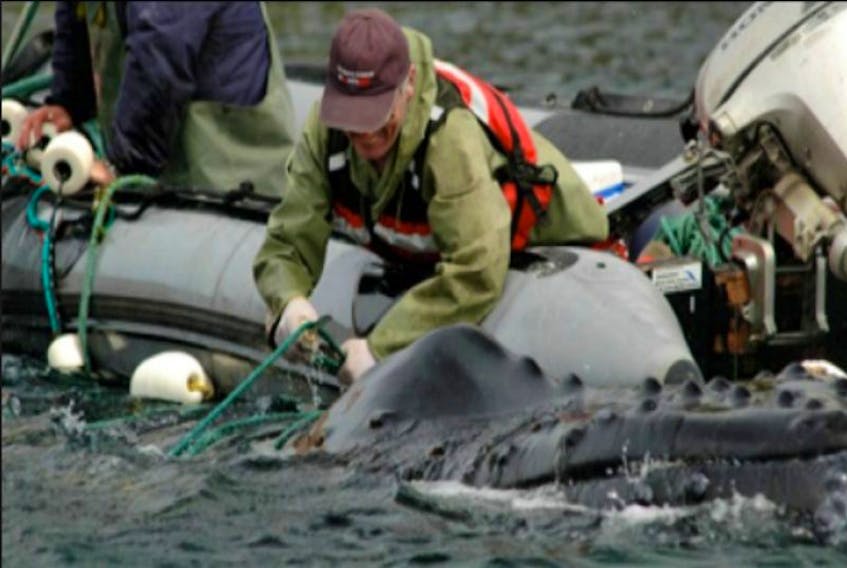
Reports of marine animals, other than fish, getting caught in fishing nets are common. Between 1979 and 2008, 1,209 large whale entanglements were recorded in Newfoundland and Labrador waters, with 120 in 1991 alone. This is where Wayne Ledwell comes in.

Related story:
Joe Howlett releasing an entangled whale in the Bay of Fundy in 2016
Ledwell is the director of the Whale Release and Strandings Group, which works with the Canadian Coast Guard to free large marine mammals caught in fishing nets, trapped in ice and in other precarious positions.
The Whale Release and Strandings Group produces reports for fishermen across the province about whales and other large marine mammals entangled in fishing ropes and nets.
Ledwell and his wife, Julie Huntington, have spent years driving across the province to assist fishermen in disentangling whales. They use a small, soft-bottom inflatable boat so as not to distress or harm the whale if it comes into contact with the vessel. Using a mask and snorkel, the rescuers look into the water to get an understanding of how the whale is tangled. They will then free it using a variety of tools, being careful to never end up in the water themselves.
Local fishermen assist the whale group by standing by in other boats in case something goes wrong, operating the motor of the rescue boat or even helping to cut the whale free.
Interacting with 50-tonnes or more of unpredictable wild animal can be dangerous, and releasers ensure safety measures are in place. These measures include having a second boat on standby and a pullback setup so the release boat can quickly be pulled out of the way if the whale starts to act up.
Accidents among releasers are relatively uncommon. One key factor in prevention is that they stay out of the water.
“People who live on the water — it’s a big risk anyways,” Ledwell says of the fishermen who help in the release effort.
Whale releases can take anywhere from one hour to an entire day, depending on the weather, the gear the animal is caught in, the temperament of the animal and whether it is anchored in one place or dragging the gear and needs to be chased.
“The animal controls the interaction,” Ledwell says of whales that are towing gear and need to be chased.
Ledwell has been involved in whale-release efforts since 1987, but he says it’s the people, more than the animals, that tie him to his work.
“It’s not always about the whale, it’s about the people and the community,” Ledwell says, “Working with the whale is the hard part … but working with the people and the community is the part I really enjoy.”
Ledwell says he has been to “every nook and cranny on the island” and loves meeting people in the communities he travels to and being welcomed into their homes to learn about them and their area.
“It’s almost like you’re fishing, but you’re out there trying to free a whale,” he says of the shared experience of the rescue effort.
The number of entangled whales that need to be released has decreased significantly with the decline of commercial fishing. With fewer boats in the water, whales are at less risk of coming into contact with fishing gear. Additionally, many of the nets now being used are light and easier to cut free than the ropes used in the past. However, whales often still become entangled in crab gear.
The Whale Release and Strandings Group has been involved with two entangled whales so far this season, but with commercial cod fishing now open, Ledwell expects to see an increase in the number of entangled whales reported.
The July 10 death of Joe Howlett, a whale rescuer out of Campobello, N.B., who was attacked after freeing an entangled right whale, has shocked the whale-rescue community.
“Things will change because of that. … Rescuers haven’t got their heads around it, and it is hard to tell if anything will change in terms of government-sponsored programs,” Ledwell says.
Right whales are not common in the Maritimes, despite the corpse of a long-dead right whale washing up on the shores of Trout River this spring. The last reported case of a right whale entangled in the area that Ledwell knows of was in 1984. While the region has the most whales of perhaps any in the world, the majority are humpback or minke whales.
Dead whales, like the one found in Trout River, are used for lab research to get a better understanding of the species.
Whale rescues have resumed in the United States, where they had been put on hold entirely following the accident in New Brunswick, but all right whale disentangling remains on hold in the United States and Canada.
The International Whaling Commission, which works to mitigate the threats faced by whales and give information to areas with fewer whales on what to do if one gets caught in fishing gear, will meet in the near future to review its guidelines for best practices.









